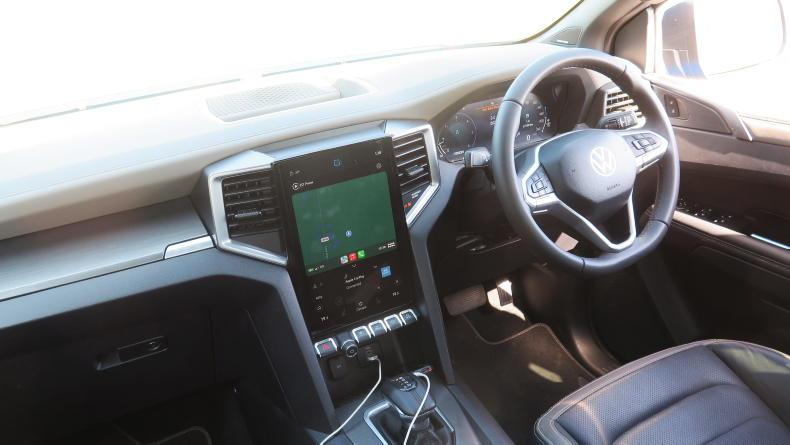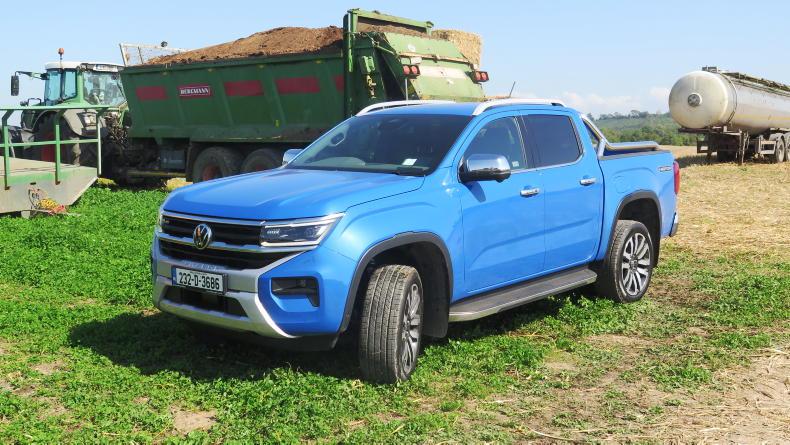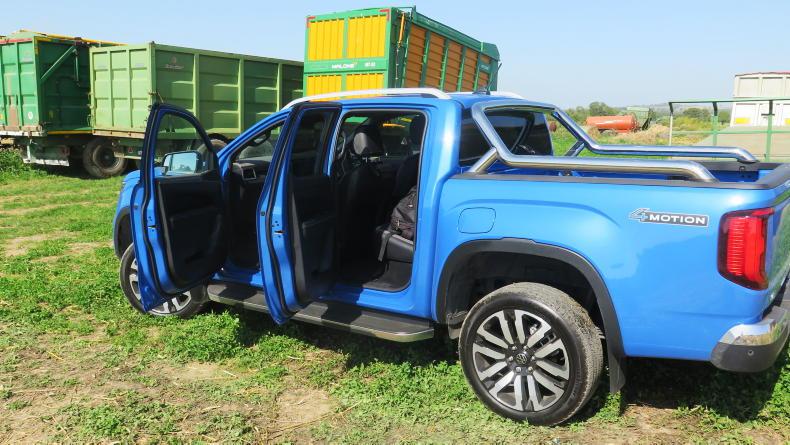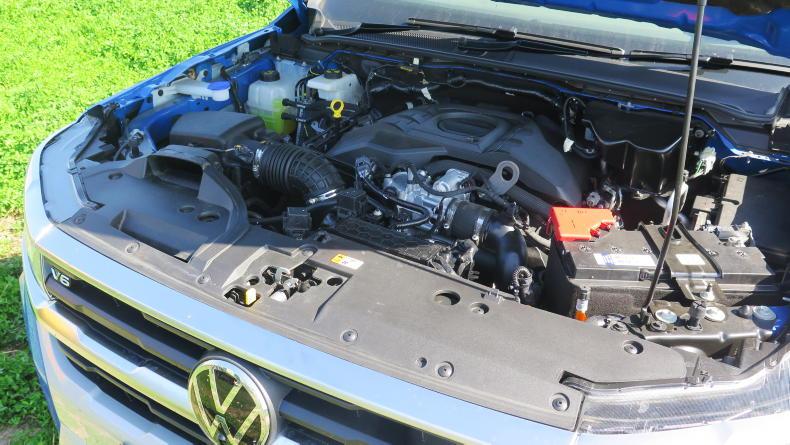In June 2023, I had the opportunity to test drive the new second-generation Volkswagen Amarok pickup. It took some months later to get behind the wheel of the newest 4x4 pickup on the Irish market, to give it what was a more thorough test drive.
My initial reaction to the Amarok was based on a short 20-minute drive. Since then, I’ve had more time to get acquainted and comfortable with the German brand workhorse, which owes much of its new pedigree to the success of the Ford’s popular Ranger 4x4 pickup.
Volkswagen wants to get a bigger share of the Irish 4x4 pickup market that by the end of November 2023 recorded sales of more than 2,300 units, one of the highest levels ever. And Ford had a hugely dominant 59% market share in that segment before the end of 2023.
Volkswagen is going about pointing the Amarok at that challenge by using the bulk of Ford’s 4x4 technology with some software tweaks and a smoother suspension. Under the skin of this Amarok is 90% or more Ford hardware from engines and gearboxes down to chassis and steering.
What Volkswagen has done is refine the engineering with more sophisticated electronic controls and a different infotainment system. Is it enough to eat into the Ford Ranger market share?
Comfort is one of the star features of the new Amarok in comparison with Ford’s Ranger.
Out on the road, this is the standout feature compared to the Ranger and more significantly Toyota’s Hilux. And comparisons are inevitable. That’s just what we have to do when we are considering a hefty investment in the likes of a 4x4 pickup that’s expected to work for its living.
The longer test version of the Amarok was the range topping Aventura specification one, not exactly a work vehicle even though Volkswagen rate its towing ability at 3.5 tonnes.
A closer look at the Vehicle Identification Sticker inside the passenger side door reveals a 3.19t gross vehicle rating and gross combination weight rating of 6.4t, which lowers the actual towing rating to 3.2t.
That aside, the three-litre V6 turbodiesel engine has plenty of power for a full load pumping out 237bhp and 600Nm of torque. The 10-speed automatic gearbox matches the engine power with a smoothness and that helps to deliver a comfortable driving experience.
I drove the Amarok over 920km in a busy week which was mostly cruising on roads. I achieved 848km on a full 80-litre capacity fuel tank, which converts to 10.6km per litre. That’s exactly the official Volkswagen rating, which might surprise you, but there was no thirsty trailer work involved. The modest off-road driving experience in stubble fields was of an unloaded 4x4 before the wetter late September conditions forced many combine harvesters to a halt.

The dash layout of the Volkswagen Amarok has a touch of Volkswagen design flair and uses more hard keys for 4x4 engagement than Ford’s Ranger offering.
Engaging the off-road options is electronic and easy using hard keys rather than touchscreen controls. You’ll easily notice the improved driving ability. This new Amarok has greater ground clearance and wading depth in water now at 800mm, than in the past.
There is also a good trailer towing feature that combines an excellent reversing camera for fast hitching with a software programme that gives a setting for each trailer attached, based on loading and power needs.

The latest Volkswagen Amarok is built by Ford built with subtle Volkswagen styling differences. Entry prices start at €48,930 or £42,099 in N. Ireland for the 2.0-litre versions.
I am reminding you, however, that towing kits are not standard for the Amarok; you have to buy one of the specification packs to get a towbar. Expect that to add significantly to the entry price which is disappointing and frankly converts to a further price increase.
On the inside, this Amarok feels very Volkswagen in terms of layout and styling. There is a large central infotainment screen that’s similar to Ford’s offering.
There’s lots of technology in the new Amarok. It comes with a generous range of standard features, including power-folding mirrors, Android Auto and Apple CarPlay integration, VW Connect with eCall Emergency System and online voice control, LED headlights, a 10.1in infotainment system, 8in multifunction display, semi-automatic air conditioning, traffic sign recognition, adaptive cruise control, rear-view camera and parking sensors. And to top it all there’s a five-star Euro NCAP crash test rating that’s similar to that of the Ford Ranger.
This new Amarok is built at a Ford plant in South Africa using Ford engines and transmissions.
So, expect some similarities, even in a design sense while the grille badges are different. And also expect more comfort from the Amarok based on my driving experience.
In an overall sense, the new Amarok feels narrower even though it is slightly longer than in the past. And it’s the longer wheelbase helps to deliver more comfort and that narrower body means it’s less intimidating for other rural road users.
Entry prices now start at €48,930, – that’s almost a €1,600 price increase since it was launched six months ago. Northern Ireland prices now start at £42,099 and they have experienced an even bigger price increase since launch.

There’s good space in the rear of the Volkswagen Amarok, with slid-feel, wide opening doors.
This Amarok deserves to boost the Volkswagen market share in the sector from its current 4.5% share because it has comfort features that others have not matched.
If you plan lots of driving and towing in the pickup of your choice for 2024, then the Amarok deserves a test drive for that alone, because in every other sense it mirrors the Ford Ranger’s ability except on price. I’m not so sure that the Amarok challenge to the Ranger success is big enough.

The three-litre, V6 turbo-diesel engine for that powers the Volkswagen Amarok delivers 237bhp and 600Nm of torque enough to ensure ample towing ability even if the Vehicle Identification Sticker rating is slightly lower than the quoted 3.5 tonnes figure.
Volkswagen Amarok 3.0 V6 TDI specifications
Engine: 3.0 litre turbo diesel. Engine power: 237bhp. Engine torque: 600Nm.0 – 100km/hr: 8.8 seconds.Economy: 10.1l/100km or 10.6km/litre.CO2 rating: 266g/km.Fuel tank capacity: 80 litres.Road tax annual: €333 taxed as commercial.Main service: 12 months.Euro NCAP rating: five-star (2022).Load area dimensions LxW (mm): 1624 x 1584. Towing capacity: 3.19 tonnes.Permissible total weight: 6.4 tonnes.Warranty: three years or 100,000km.Entry price: €48,930 including VAT.
Entry price in NI: £42,099 including VAT.
In June 2023, I had the opportunity to test drive the new second-generation Volkswagen Amarok pickup. It took some months later to get behind the wheel of the newest 4x4 pickup on the Irish market, to give it what was a more thorough test drive.
My initial reaction to the Amarok was based on a short 20-minute drive. Since then, I’ve had more time to get acquainted and comfortable with the German brand workhorse, which owes much of its new pedigree to the success of the Ford’s popular Ranger 4x4 pickup.
Volkswagen wants to get a bigger share of the Irish 4x4 pickup market that by the end of November 2023 recorded sales of more than 2,300 units, one of the highest levels ever. And Ford had a hugely dominant 59% market share in that segment before the end of 2023.
Volkswagen is going about pointing the Amarok at that challenge by using the bulk of Ford’s 4x4 technology with some software tweaks and a smoother suspension. Under the skin of this Amarok is 90% or more Ford hardware from engines and gearboxes down to chassis and steering.
What Volkswagen has done is refine the engineering with more sophisticated electronic controls and a different infotainment system. Is it enough to eat into the Ford Ranger market share?
Comfort is one of the star features of the new Amarok in comparison with Ford’s Ranger.
Out on the road, this is the standout feature compared to the Ranger and more significantly Toyota’s Hilux. And comparisons are inevitable. That’s just what we have to do when we are considering a hefty investment in the likes of a 4x4 pickup that’s expected to work for its living.
The longer test version of the Amarok was the range topping Aventura specification one, not exactly a work vehicle even though Volkswagen rate its towing ability at 3.5 tonnes.
A closer look at the Vehicle Identification Sticker inside the passenger side door reveals a 3.19t gross vehicle rating and gross combination weight rating of 6.4t, which lowers the actual towing rating to 3.2t.
That aside, the three-litre V6 turbodiesel engine has plenty of power for a full load pumping out 237bhp and 600Nm of torque. The 10-speed automatic gearbox matches the engine power with a smoothness and that helps to deliver a comfortable driving experience.
I drove the Amarok over 920km in a busy week which was mostly cruising on roads. I achieved 848km on a full 80-litre capacity fuel tank, which converts to 10.6km per litre. That’s exactly the official Volkswagen rating, which might surprise you, but there was no thirsty trailer work involved. The modest off-road driving experience in stubble fields was of an unloaded 4x4 before the wetter late September conditions forced many combine harvesters to a halt.

The dash layout of the Volkswagen Amarok has a touch of Volkswagen design flair and uses more hard keys for 4x4 engagement than Ford’s Ranger offering.
Engaging the off-road options is electronic and easy using hard keys rather than touchscreen controls. You’ll easily notice the improved driving ability. This new Amarok has greater ground clearance and wading depth in water now at 800mm, than in the past.
There is also a good trailer towing feature that combines an excellent reversing camera for fast hitching with a software programme that gives a setting for each trailer attached, based on loading and power needs.

The latest Volkswagen Amarok is built by Ford built with subtle Volkswagen styling differences. Entry prices start at €48,930 or £42,099 in N. Ireland for the 2.0-litre versions.
I am reminding you, however, that towing kits are not standard for the Amarok; you have to buy one of the specification packs to get a towbar. Expect that to add significantly to the entry price which is disappointing and frankly converts to a further price increase.
On the inside, this Amarok feels very Volkswagen in terms of layout and styling. There is a large central infotainment screen that’s similar to Ford’s offering.
There’s lots of technology in the new Amarok. It comes with a generous range of standard features, including power-folding mirrors, Android Auto and Apple CarPlay integration, VW Connect with eCall Emergency System and online voice control, LED headlights, a 10.1in infotainment system, 8in multifunction display, semi-automatic air conditioning, traffic sign recognition, adaptive cruise control, rear-view camera and parking sensors. And to top it all there’s a five-star Euro NCAP crash test rating that’s similar to that of the Ford Ranger.
This new Amarok is built at a Ford plant in South Africa using Ford engines and transmissions.
So, expect some similarities, even in a design sense while the grille badges are different. And also expect more comfort from the Amarok based on my driving experience.
In an overall sense, the new Amarok feels narrower even though it is slightly longer than in the past. And it’s the longer wheelbase helps to deliver more comfort and that narrower body means it’s less intimidating for other rural road users.
Entry prices now start at €48,930, – that’s almost a €1,600 price increase since it was launched six months ago. Northern Ireland prices now start at £42,099 and they have experienced an even bigger price increase since launch.

There’s good space in the rear of the Volkswagen Amarok, with slid-feel, wide opening doors.
This Amarok deserves to boost the Volkswagen market share in the sector from its current 4.5% share because it has comfort features that others have not matched.
If you plan lots of driving and towing in the pickup of your choice for 2024, then the Amarok deserves a test drive for that alone, because in every other sense it mirrors the Ford Ranger’s ability except on price. I’m not so sure that the Amarok challenge to the Ranger success is big enough.

The three-litre, V6 turbo-diesel engine for that powers the Volkswagen Amarok delivers 237bhp and 600Nm of torque enough to ensure ample towing ability even if the Vehicle Identification Sticker rating is slightly lower than the quoted 3.5 tonnes figure.
Volkswagen Amarok 3.0 V6 TDI specifications
Engine: 3.0 litre turbo diesel. Engine power: 237bhp. Engine torque: 600Nm.0 – 100km/hr: 8.8 seconds.Economy: 10.1l/100km or 10.6km/litre.CO2 rating: 266g/km.Fuel tank capacity: 80 litres.Road tax annual: €333 taxed as commercial.Main service: 12 months.Euro NCAP rating: five-star (2022).Load area dimensions LxW (mm): 1624 x 1584. Towing capacity: 3.19 tonnes.Permissible total weight: 6.4 tonnes.Warranty: three years or 100,000km.Entry price: €48,930 including VAT.
Entry price in NI: £42,099 including VAT.










 This is a subscriber-only article
This is a subscriber-only article










SHARING OPTIONS: